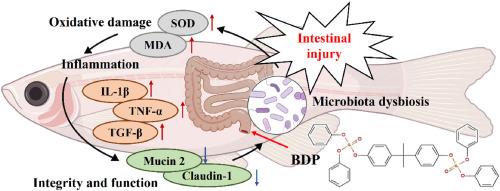Bisphenol A bis(diphenyl phosphate) disrupts gut microbiota homeostasis and induces intestinal toxicity in zebrafish
IF 7.3
2区 环境科学与生态学
Q1 ENVIRONMENTAL SCIENCES
引用次数: 0
Abstract
Bisphenol A bis(diphenyl phosphate) (BDP), a widely used oligomeric organophosphorus flame retardant, is widespread in environments and organisms. However, the toxicity of BDP remains largely unexplored. The intestine is an immune organ and is subjected to injury caused by contaminants. Here zebrafish were exposed to 0, 10 and 100 μg/L BDP for 21d, followed by another 21d of recovery, to investigate its intestinal toxicity. BDP altered the gut microbiota compositions with obvious changes in the abundance of phyla Proteobacteria and Fusobacteria, and genera Cetobacterium, Hydrogenophaga and Aeromonas, leading to intestinal dysbiosis. Consequently, distinct intestinal histopathological alteration was observed in the BDP-exposed zebrafish. The expressions of Claudin-1 and Mucin 2 decreased dose-dependently, whose disruption was persistent, indicating that BDP destroyed the barrier integrity and function of intestine. In addition, superoxide dismutase (SOD) and malondialdehyde (MDA), as well as the expressions of interleukin-1β (IL-1β), tumor necrosis factor-α (TNF-α) and transforming growth factor-β (TGF-β) increased, magnifying the occurrence of oxidative damage and inflammation. Significant correlation was found between the microbiota alteration and intestinal disruptions, suggesting that BDP-induced gut microbiota dysbiosis participates in the progression of intestinal injury. This study reveals the intestinal toxicity of BDP, and provides insights into its potential risks in organisms.

双酚A双(磷酸二苯酯)破坏肠道微生物群稳态并诱导斑马鱼肠道毒性
双酚A -磷酸二苯酯(BDP)是一种应用广泛的低聚有机磷阻燃剂,广泛存在于环境和生物中。然而,BDP的毒性在很大程度上仍未被探索。肠道是一种免疫器官,容易受到污染物的伤害。本研究将斑马鱼分别暴露于0、10和100 μg/L的BDP中21d,然后再恢复21d,以研究其肠道毒性。BDP改变了肠道菌群组成,变形菌门和梭杆菌门以及鲸杆菌属、食氢菌属和气单胞菌属的丰度发生了明显变化,导致肠道生态失调。因此,在暴露于bdp的斑马鱼中观察到明显的肠道组织病理学改变。Claudin-1和Mucin - 2的表达呈剂量依赖性下降,其破坏是持续性的,表明BDP破坏了肠屏障的完整性和功能。此外,超氧化物歧化酶(SOD)、丙二醛(MDA)以及白细胞介素-1β (IL-1β)、肿瘤坏死因子-α (TNF-α)、转化生长因子-β (TGF-β)表达升高,放大了氧化损伤和炎症的发生。肠道菌群改变与肠道紊乱之间存在显著相关性,提示bdp诱导的肠道菌群失调参与了肠道损伤的进展。这项研究揭示了BDP的肠道毒性,并为其在生物体中的潜在风险提供了见解。
本文章由计算机程序翻译,如有差异,请以英文原文为准。
求助全文
约1分钟内获得全文
求助全文
来源期刊

Environmental Pollution
环境科学-环境科学
CiteScore
16.00
自引率
6.70%
发文量
2082
审稿时长
2.9 months
期刊介绍:
Environmental Pollution is an international peer-reviewed journal that publishes high-quality research papers and review articles covering all aspects of environmental pollution and its impacts on ecosystems and human health.
Subject areas include, but are not limited to:
• Sources and occurrences of pollutants that are clearly defined and measured in environmental compartments, food and food-related items, and human bodies;
• Interlinks between contaminant exposure and biological, ecological, and human health effects, including those of climate change;
• Contaminants of emerging concerns (including but not limited to antibiotic resistant microorganisms or genes, microplastics/nanoplastics, electronic wastes, light, and noise) and/or their biological, ecological, or human health effects;
• Laboratory and field studies on the remediation/mitigation of environmental pollution via new techniques and with clear links to biological, ecological, or human health effects;
• Modeling of pollution processes, patterns, or trends that is of clear environmental and/or human health interest;
• New techniques that measure and examine environmental occurrences, transport, behavior, and effects of pollutants within the environment or the laboratory, provided that they can be clearly used to address problems within regional or global environmental compartments.
 求助内容:
求助内容: 应助结果提醒方式:
应助结果提醒方式:


